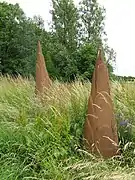| Portrack Incinerator | |
|---|---|
 | |
| Country | England |
| Location | County Durham, North East England |
| Coordinates | 54°34′16″N 1°16′00″W / 54.571196°N 1.266791°W |
| Commission date | 1975 |
| Decommission date | 1996 |
| Operator(s) | |
| Thermal power station | |
| Primary fuel | Waste |
grid reference NZ475198 | |
The Portrack Incinerator was a municipal waste incinerator and waste-to-energy power station situated on the River Tees at Portrack in Stockton-on-Tees in County Durham, England.
Incinerator history
The incinerator was opened in 1975 to burn the domestic waste of the four local authorities of Middlesbrough, Stockton on Tees, Redcar & Cleveland and Hartlepool.[1] It was praised as an environmentally friendly answer to waste management on Teesside.[2] The plant burned approximately 200,000 tonnes of waste every year and had the potential capacity to generate 20 megawatts (MW) of electricity although it never actually did so.[1] Ash from the incinerator was sent to landfill and ferrous metal baled and sold on as scrap. During the 1980s, a former quarry at Whitton was used as a site to dump the incinerator's ash.[3]
In the early 1990s, Northumbrian Water and Internal Technology Europe Ltd. applied for planning permission to build a sludge incinerator alongside the waste incinerator. These plans were refused, despite an appeal in 1992.[4]
The incinerator was closed down in November 1996, after failing to meet new emission regulations. The plant was then demolished and its site cleared between 1998 and 2000.[1] The incinerator's 300-foot (91 m) tall chimney was demolished on 14 March 1999.[5] The budget for the demolition went into the red in early 2000.[6] The north part of the site was used as the Stockton civic amenity dump, until it closed in December 2001.[1]
The incinerator was superseded by the Teesside WTE Power Station a couple of miles down river at Haverton Hill.
| Portrack Meadows Wildlife Reserve | |
|---|---|
 Location within England | |
| Location | Stockton-on-Tees, England |
| Operated by | Tees Valley Wildlife Trust |
| Website | teeswildlife.org |
Portrack Meadows Wildlife Reserve
After the Portrack Incinerator site was cleared it was transformed into a site for recreation and wildlife and named Portrack Meadows Wildlife Reserve.[1] The site is managed by Tees Valley Wildlife Trust who have placed several interpretation boards around the site for the visitor. At the site's blocked-off northern road entrance is a public sculpture entitled Germination (2005) commissioned by Tees Valley Wildlife.[7][8]
Flora
Many trees were planted around the incinerator to screen it off, but when the site was cleared to give other plants a chance to grow, many of these trees were pollarded. After clearing the incinerator site it was planted with hedgerows, oak trees and sown with wildflower seeds.[8][9] However the concrete base of the incinerator still remains under the site—a fact that may account for the extremely dense vegetation.
 Portrack Meadows with the A19 Tees Viaduct in the distance
Portrack Meadows with the A19 Tees Viaduct in the distance Germination sculpture at the entrance at the north end of the Portrack Meadows site
Germination sculpture at the entrance at the north end of the Portrack Meadows site
References
- 1 2 3 4 5 "Portrack Meadows". Tees Wildlife. Archived from the original on 20 November 2008. Retrieved 20 April 2009.
- ↑ Delplanque, Paul (9 May 2008). "What a load of rubbish!". Gazette Live. Teesside: Evening Gazette. Archived from the original on 11 May 2008. Retrieved 20 April 2009.
- ↑ "Honey Pot Wood". Stockton-on-Tees. Stockton-on-Tees Borough Council. Archived from the original on 2 December 2008. Retrieved 21 April 2009.
- ↑ Mr. Baldry (27 October 1992). "Sludge Incinerators". Parliamentary Debates (Hansard). Retrieved 2 September 2009.
- ↑ "Symbolism of a new skyline". Wiki NorthEast. 15 March 1999. Retrieved 21 April 2009.
- ↑ Kelly, June (8 January 2000). "The knock-down price". Retrieved 25 September 2009.
- ↑ "andrew mckeown - sculptor". Andrew McKeown. Archived from the original on 28 October 2009. Retrieved 3 July 2009.; "andrew mckeown - sculptor". Archived from the original on 28 October 2009. Retrieved 3 July 2009.; "New Shoots". Teesside: Evening Gazette. 16 November 2005. Archived from the original on 22 November 2008. Retrieved 3 July 2009.; Thomas-Bailey, Carlene (4 April 2009). "Seeds of change". The Guardian. Retrieved 27 July 2009.
- 1 2 "Sculptures grace restored incinerator site". Darlington: The Northern Echo. 29 June 2005. Archived from the original on 1 October 2012. Retrieved 27 July 2009.
- ↑ "Chain Gang". Teesside: Evening Gazette. 18 May 2005. Archived from the original on 7 October 2008. Retrieved 3 July 2009.; "Turf's up as mayors help create avenue of oak trees at nature site". Darlington: The Northern Echo. 14 April 2005. Retrieved 3 July 2009.
